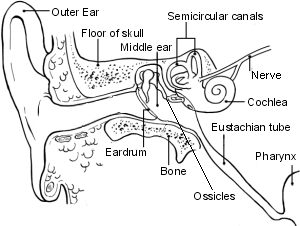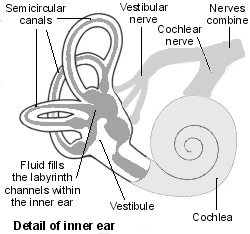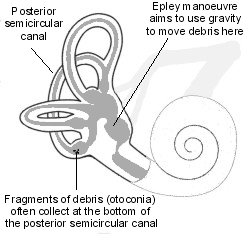Conditions Explained
Disclaimer:
This website is intended to assist with patient education and should not be used as a diagnostic, treatment or prescription service, forum or platform. Always consult your own healthcare practitioner for a more personalised and detailed opinion
Benign Paroxysmal Positional Vertigo (BPPV)
We have selected the following expert medical opinion based on its clarity, reliability and accuracy. Credits: Sourced from the website Patient UK, authored by Dr Jacqueline Payne, reviewed by Prof Cathy Jackson (see below). Please refer to your own medical practitioner for a final perspective, assessment or evaluation.
Overview
Benign paroxysmal positional vertigo causes short episodes of intense dizziness (vertigo) when you move your head in certain directions. Vertigo is the sensation that you or your surroundings are moving. Benign paroxysmal positional vertigo is thought to be caused by tiny solid fragments (otoconia) in the inner ear labyrinth. In many cases the condition gets better on its own after several weeks. A simple treatment of moving the head into various positions over a few minutes can cure the condition in many cases. This treatment uses gravity to move the tiny fragments away from where they are causing problems.
What is benign paroxysmal positional vertigo (BPPV)?
BPPV is a condition of the inner ear. It is a common cause of intense dizziness (vertigo), especially in older people.
- Benign means that it is due neither to a cancerous nor a serious cause. (The symptoms of BPPV may be unpleasant but the underlying cause is not serious.)
- Paroxysmal means recurring sudden episodes of symptoms.
- Positional means that the symptoms are triggered by certain positions. In the case of BPPV, it is certain positions of the head that trigger symptoms.
- Vertigo is dizziness with a sensation of movement. If you have vertigo you feel as if the world is moving around you or that you are moving when you aren't. You feel very unsteady, a bit like being on a ship. Often you will also feel sick (nauseated), although you will not usually be sick (vomit).
Understanding the inner ear
The inner ear includes the cochlea and semicircular canals. These are small shell-like structures in which there is a system of narrow fluid-filled channels called the labyrinth. The semicircular canals sense movement of your head and help to control balance and posture. The cochlea is concerned with hearing.
Cross-section of the ear


There are three semicircular canals (anterior, lateral and posterior). These are roughly at right angles to each other and sense movement in different directions - left-right, forward-back and up-down head movements. The three semicircular canals are connected to a larger fluid-filled chamber called the vestibule, which in turn is connected to the fluid-filled canal in the cochlea.
Head movements are sensed because when you move your head, the fluid in the labyrinth within the semicircular canals moves too. The movement of the fluid moves tiny fine hairs that are on the inside lining of the labyrinth.
When the hairs move, this triggers nerve messages to be sent to the brain via a nerve called the vestibular nerve. This gives the brain information about the movement and position of your head, even when your eyes are closed.
What you can see and nerve messages from the joints and muscles of the body also help to tell your brain about your position and posture. However, a properly working labyrinth in each ear is needed for a good sense of posture and balance.
What happens in benign paroxysmal positional vertigo (BPPV)?
It is thought that BPPV is caused by one or more tiny solid fragments (otoconia) that float about in the fluid of the labyrinth. The fragments are made up of calcium carbonate crystals which are thought to have broken off from the inside lining of the vestibule part of the labyrinth. These cause no problems if the fragment remains in the vestibule. However, problems occur if a fragment gets into one of the semicircular canals.

The posterior canal is the usual one affected. In this situation, when your head is still, the fragment sits at the bottom of the posterior canal. But when the head moves in certain directions the fragment gets carried along with the flow of fluid.
The fragment brushes along the delicate hairs that line the semicircular canal and this bombards messages down the vestibular nerve. The extra nerve messages sent from the affected ear conflict with the normal messages sent from the other unaffected ear and from the eyes and the rest of the body. The brain becomes very confused and reacts with vertigo.
It is not clear why these otoconia form or drop off from the inside lining of the labyrinth. Most cases of BPPV occur in people over the age of 40. Therefore, it may be an age-related thing. BPPV is one of the most common causes of vertigo in older people. However, some younger people develop BPPV following an injury to the ear, or following a previous infection in the inner ear. Sometimes it occurs in younger people for no apparent reason. Women are affected about twice as often as men.
Symptoms
What are the symptoms of benign paroxysmal positional vertigo (BPPV)?
The main symptom is vertigo. The vertigo lasts just a short time - typically just for 20-30 seconds and usually no longer than a minute. It then goes away completely if you keep your head still. The vertigo is usually triggered by a change in head position. For example, getting out of bed and rolling over in bed are two of the most common movements that trigger a short episode of vertigo. Sometimes just looking up triggers an episode of vertigo.
With each episode of vertigo you may feel sick (nauseated) but it is not common to be sick (vomit). The nausea may last an hour or so even though the vertigo lasts just seconds.
Between episodes of BPPV you feel well. Many people who develop BPPV realise which head movements trigger their symptoms and so instinctively avoid doing those movements.
In most cases, the symptoms clear away within several weeks or months. The solid fragments (otoconia) may dissolve or float out from the posterior semicircular canal and lodge in the vestibule where they cause no symptoms. However, after the symptoms have gone, some people have recurrences of symptoms months or years later. In some cases, symptoms persist for years.
Diagnosis
Do I need any tests?
The symptoms of benign paroxysmal positional vertigo (BPPV) are quite characteristic and so a doctor may well suspect that you have this condition by your symptoms. To confirm the diagnosis your doctor may do a test called the Dix-Hallpike manoeuvre. This will involve you sitting on a doctor's couch. The doctor will then ask you to lie back and move your head in certain directions. These set movements in people with BPPV will usually trigger an episode of vertigo.
Treatment
What is the treatment for benign paroxysmal positional vertigo (BPPV)?
The Epley manoeuvre
This simple cure may be tried by your doctor. This often works if you have fragments of debris (otoconia) at the bottom of your posterior semicircular canal (the common situation). This is done by a series of four movements of the head. After each movement, the head is held in the same place for 30 seconds or so.
The movements of the head basically cause the posterior semicircular canal to rotate around in such a way that gravity moves the otoconia fragments out from the posterior canal and into the vestibule where they then settle and cause no symptoms.
Some studies report that the Epley manoeuvre is successful in stopping symptoms in about 8 in 10 cases with just one treatment. If the first treatment does not work, there is still a good chance that it will work in a repeated treatment session a week or so later. If successful, the Epley manoeuvre is one of the few procedures that can be done in a doctor's surgery in a few minutes and that can dramatically cure a patient of symptoms! If symptoms return at a later date, the manoeuvre can be repeated.
Brandt-Daroff exercises
You may be recommended to do these if the Epley manoeuvre does not work. These exercises involve a different way of moving the head compared to the Epley manoeuvre. Your doctor will advise you on how to do these if they are recommended.
No treatment
If the Epley manoeuvre or Brandt-Daroff exercises are not successful, or not done, you can still remain optimistic. BPPV is a condition that usually goes away on its own after several weeks or months without any treatment. One study said the condition had resolved in many people with BPPV in an average of 10 weeks. The otoconia are thought either to dissolve or move to a place in the labyrinth where they cause no symptoms.
Surgery
Surgery is extremely rare, as in most cases the condition either improves by itself or can be cured by the Epley manoeuvre. If symptoms persist for months or years and cannot be eased, an operation of the inner ear to take out the function of the posterior semicircular canal may then be an option. A doctor who is an ear specialist will advise.
How do I keep safe while I have benign paroxysmal positional vertigo (BPPV)?
- The DVLA recommends that you should stop driving if you have sudden, unexpected and disabling attacks of dizziness.
- You should inform your employer if BPPV could pose a risk to yourself or others in your job. For example, if you use ladders, operate heavy machinery, or drive.
- To avoid falls around the home, get out of bed slowly and avoid jobs around the house that involve looking upwards.
About the author
Dr Jacqueline Payne (Author)
MB BS, DFFP, DRCOG, FRCGP
Jacqueline was a GP in Kendal, Cumbria for 25 years, where she trained young GPs for the RCGP and was an Instructing Doctor for the FSRH. She has a Postgraduate Diploma in Prescribing Science from the University of Liverpool and was Prescribing lead for the South Lakes area for many years and has worked with the National Prescribing Centre. She also has a Postgraduate Diploma in Gynaecology from the University of Bradford and was the FSRH Training Programme Director for South Cumbria until 2015. She was elected Fellow of the RCGP in 2012. Her main clinical interests are women's health and prescribing. However, as a keen cyclist she also takes a personal interest in Sports Medicine.
Prof Cathy Jackson (Reviewer)
BSc (Hons) (Physiology), MB ChB, MRCGP, MD
Cathy qualified in 1983 and has been a member of the EMIS (patient.info) team since 2002 (the first 5 years as an author, now a peer-reviewer). Cathy is Dean of the Faculty of Clinical and Biomedical Sciences at UCLan and Head of the School of Medicine. She is a Professor of Primary Care Medicine with a research interest in asthma, COPD and inflammatory airway disease. She is passionate about providing remote and rural educational experiences for health care students and also in ensuring CPD opportunities for graduates in the skills required to practice in these areas e.g. urgent and pre- hospital emergency care, leadership and the use of digital technology.
_______________________________________________________________________________________________________________________
Are you a healthcare practitioner who enjoys patient education, interaction and communication?
If so, we invite you to criticise, contribute to or help improve our content. We find that many practicing doctors who regularly communicate with patients develop novel and often highly effective ways to convey complex medical information in a simplified, accurate and compassionate manner.
MedSquirrel is a shared knowledge, collective intelligence digital platform developed to share medical expertise between doctors and patients. We support collaboration, as opposed to competition, between all members of the healthcare profession and are striving towards the provision of peer reviewed, accurate and simplified medical information to patients. Please share your unique communication style, experience and insights with a wider audience of patients, as well as your colleagues, by contributing to our digital platform.
Your contribution will be credited to you and your name, practice and field of interest will be made visible to the world. (Contact us via the orange feed-back button on the right).